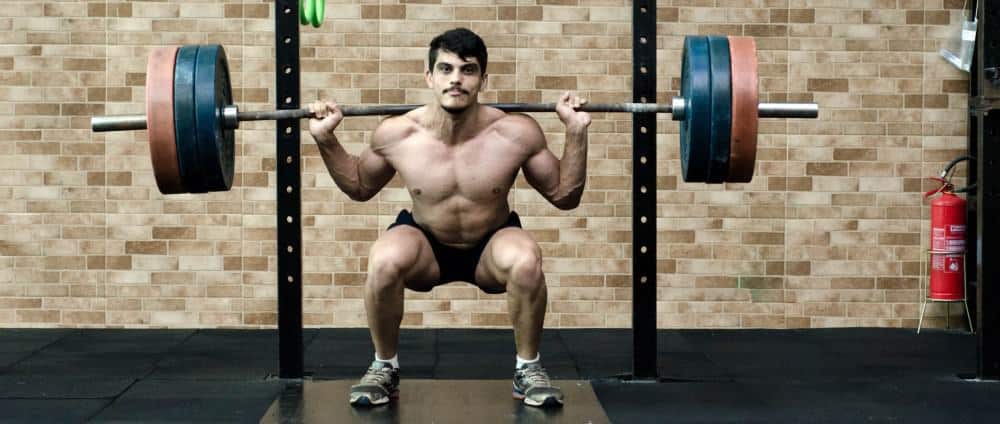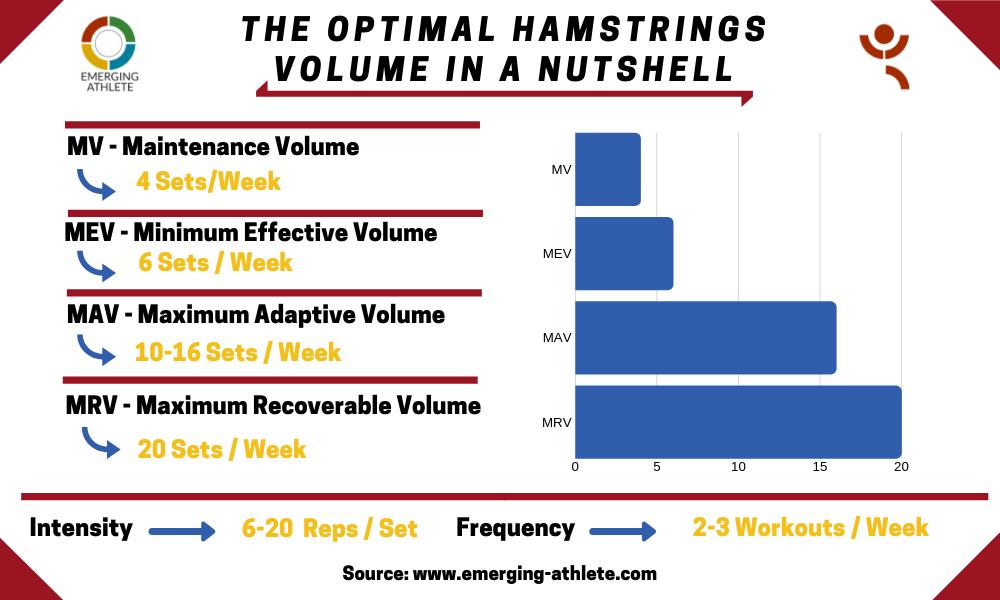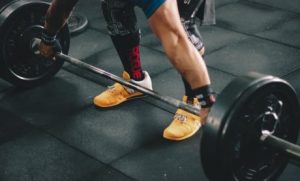If you still have some questions about volume, what that actually is, how it affects our muscle growth and what you should know about it, check out our free guide about the optimal volume for hypertrophy.
What can you expect from this article and the whole series about volume in general?
Based on Dr Mike Israetel’s knowledge and experience, as well as our own, we want to clarify which volume works best for each muscle.

Most of you probably like to curl in the gym, am I right with that?
Good that you here!
Today, we’re going to take a closer look at our biceps, oh wait a minute… Did I say biceps?
Of course, we’re talking about our leg biceps alias hamstrings;)
I hope all of you’ve read the previous article about the optimal quads volume and refueled your motivation to stop skipping leg days!
Today, I am going to elaborate on all important aspects of the optimal hamstrings volume.
How often do you see people working out their hamstrings?
Alright. And how often do you see people working out their chest, biceps or abs?
Exactly, it is actually a shame but unfortunately, nowadays the priority definitely tends to be more on the clearly visible body parts.
I mean yeah it is true, your legs are covered through pants most time during the year, but does that count as an excuse to skip leg days?
Certainly not. There is no reasonable excuse except diminishing your own potential to grow since lower body workouts have tremendous benefits which I’ve talked about in the optimal quads volume article.
If you have chicken legs, for sure that’s not the best thing that could’ve to happen to you, but still, it’s on you to start doing something against the “bad genetics” and make them grow!
As it is with almost every aspect of life, everybody has different starting situations, conditions, and capabilities.
But eventually, it is up to you what you make out of your circumstances and your life!
Complaining all day long about how bad your life is and how lucky others are doesn’t get you anywhere.
Stop blaming others, stop talking and start doing. We all only have this one life!
With that in mind, it’s pretty questionable why we should solely focus training on half of our body?
Sooner or later you’ll get injuries, pain, and suffer from an abbreviation of certain muscles.
Who wants that? Who aims to endanger his own body?
If you now think about, it makes sense. But as always talking about theory is easier than actually implementing it into practice.
However, let me clarify one thing.
I wasn’t really any different.
When I started working out, my main goal was the same thing that every guy wanted.
Get bigger arms, a chest like a superhero and a sixpack…
There wasn’t really any space in my mind for these things where we’re walking on 24/7, so-called legs.
It took quite some time until I realized how stupid I was.
Not only does it look ugly, but it also increases your risk to injuries and even reduces your potential muscle growth.
Might training legs might even benefit us?
Damn, that’s a weird ass assumption, but you’re totally right!
I’ve gathered some of the most beneficial impacts of exercising our legs and listed them below.
Benefits from leg days:
- You’ll build more muscle
- You’ll burn more calories
- You won’t look like a chicken
- You’ll reduce the risk of injury
- You’ll improve your big lifts
- You’ll strengthen your abs
If you want to read more in-depth about these benefits and why you SHOULDN’T skip leg day, check out my latest article here.
Furthermore, Shawn Garcia and Men’s Health have good articles about these topics that go more in-depth as well.
MV – Maintenance Volume
What does MV mean?
MV equals Maintenance Volume and refers to the amount of work that is required to maintain your muscle’s current size.
Why is it important to know your MV?
Pretty logical.
If you have to reduce your workouts for a certain reason, you don’t want to lose your hard acquired gains, do you?
So it is of great importance to know how much volume you need to maintain your muscles current size.
Furthermore, after a period of absolutely exhausting workouts in between your MAV and MRV or even above, it is for sure a good thing to lower your volume every so often.
This way, your body is able to desensitize and fully recover again.
Sometimes it is even necessary to implement such phases, called “deload“. A lot of athletes conduct such breaks after 4-5 weeks of training.
As a result, your body can recover and regain its full in charge of its strength.
Moreover, you need to change exercises over time to stimulate new incentives and increase variety.
Summing up, it is crucial knowing the MV and being aware of what you can use as a good benchmark to ensure you don’t lose any muscles, as well as keeping the volume in your “deload phase” appropriate which often tends to be too high.
What’s the MV for the optimal hamstrings volume?
MV: 4 sets/week
That sounds not really a lot, and it actually isn’t but we’re still talking about heavy sets.
This is on average enough to maintain your hamstring’s current size if, for instance, you have to move back from hamstrings workout because you may want to prioritize other muscles or need to recover.
MEV – Minimum Effective Volume
What means MEV?
Minimum Effective Volume describes the least amount of work that is necessary to stimulate some muscle growth.
Why is it important to know your MEV?
To put it in a nutshell, just like it’s important to know how much volume your hamstrings need to maintain its current size, it is at least of similar importance to know how much volume is required to grow your hamstrings.
What’s the MEV for the optimal hamstrings volume?
MEV: 6 sets/week
Same case here.
It doesn’t sound like much work but if you train hard, means heavy sets with proper technique, your hamstrings really get messed up from relatively little.
With this in mind, most individuals tend to see some growth on their hamstrings with about 6 heavy sets/week on average.
MAV – Maximum Adaptive Volume
What does MAV stand for?
MAV is a shortcut for Maximum Adaptive Volume which reveals the amount of work where probably most of the muscle growth happens.
Why is it important to know your MAV?
Counterquestion: Do you want to train all your time with only the least effective muscle growth?
Exactly, I doubt that!
In order to stimulate the best possible muscle growth, we need to put more effort into our workout and increase the volume consistently.
That is why it is important to know what the MAV is and also which benchmark we can refer to for maximizing muscle growth.
How much volume tends to stimulate the optimal hamstrings volume?
MAV: 10-16 sets/week
Most individuals experience quite decent progress with a volume between 10-16 sets/week.
Dr. Mike Israetel said in his video that he haven’t seen a lot of folks who respond well to 16 sets/week of hamstrings.
This almost seems to be overkill and eventually doesn’t get you any further.
Therefore, most people tend to be on the lower end here, closer to 10 than 16 sets/week.
Of course, there are exceptions as always.
The only way to find out what works best for you is by experimentation and keeping track of your own progress.

MRV – Maximum Recoverable Volume
What does MRV mean?
It stands for Maximum Recoverable Volume which refers to the maximum amount of work that can be fully recovered by your body.
In other words, the maximum amount of work that your body can sustain until your strength and performance may even decrease in the long run.
Sooner or later in your mesocycle program, you will reach a plateau and your performance starts to stagnate or even decrease.
This is an indication that you probably overreached your MRV.
So why is it important to know your MRV?
After all, that can be answered relatively easy.
I suppose nobody of you wants to take a forced break only because you accumulated too much volume during your own training program.
For this reason, it is very crucial to know where your MRV lies to keep your body recovered and avoid superfluous breaks.
What is the MRV for the optimal hamstrings volume?
MRV: 20 sets/week
On average, the highest volume tolerated, is about 20 sets/week.
Usually, that’s for individuals that tend to be compound of more slow-twitched muscles fibers, that have a long history of high-level training volume and former endurance runners.
They might be able to sustain such a volume, but for most people that don’t work at all.
Frequency
How often can and should we train for the optimal hamstrings volume?
2-3 workouts/week
A frequency of 2-3 times/week seems to be sufficient because hamstrings really get disrupted relatively easy.
Especially hip hinge movements damage hamstrings heavily.
This means a frequency over 3 times/week is likely to be too much for most individuals because you need the additional time to recover properly.
Intensity
Hip Hinge Movements: 70-85% of your 1-RM, usually in a 6-10 rep range
What does 1-RM mean?
In short, it means One (1) Rep (R) Max (M).
Basically, your one rep max (1-RM) refers to a weight that you can carry just once with maximum effort.
Exercises like good mornings, glute ham raises and deadlifts are the massive hamstring building ones which should be done pretty heavily.
Hamstring Curls: 60-75 % of your 1-RM, usually in a 10-20 rep range
Nevertheless, hamstring curls are important because they hit part of the muscles which hip hinge movements don’t cover and round out the look of your legs.
In general, for safety reasons and because the hip hinge movements already take care of the heavy load, hamstrings curls should be done lighter with around 60-75% of your 1-RM and a rep range between 10-20 reps per set.
Hamstring workout – Exercises
What exercises are most effective for the optimal hamstrings volume?
Dr. Mike Israetel represents the point of view that only leg curls will not bring along the biggest hams.
Big hams are built by heavy exercises like good mornings and stiff-leg deadlifts.
Individuals that do these kinds of exercises almost certainly have big hams.
Some of the most common and effective hamstring exercises are:
- Good mornings (Barbell)
- Stiff-leg deadlifts
- Squats (indeed they train your hamstrings as well)
- All variations of leg curls (Dumbbell or Machine)
- Sumo squats
- Glute ham raises
Regarding all these exercises, there are a lot of different variations.
I recommend you to try them out and choose your favorite one.
Over time you can switch between these exercises in your mesocycles to increase variety for the optimal hamstrings volume.
In order to get the best results, I would also recommend implementing both types of exercises, heavy ones (good mornings, stiff-leg deadlifts) and isolation work (leg curls).
Range of Motion
I think it should be clear to you by now that range of motion always plays a big deal and should never be sacrificed for heavier weights.
Especially for muscles like hamstrings that need a good contraction and technique to feel them properly, range of motion is even more important!
For exercises like good mornings, you definitely have to go deep enough in order to create the eccentric pulling apart damage on the hamstrings.
Wait, but what is deep enough?
This depends on your hamstrings flexibility and general mobility.
As a rule of thumb, it should be a deep stretch that you feel properly in your hamstrings.
But most importantly, your back needs to be tight!
For exercises like glute ham raises it should look like it follows; your knees are back, your hips are up and your back is tight when there is a deeply painful (not triggered by injury) stretch.
If that sounds like you, you’re probably good to go!
For hamstring curls, you really want to feel the contraction inside your muscles.
A good way to do them is by pausing at the very top and then slowly let off the eccentric phase, pause again and repeat.
Obeying all these aspects, I assure that you’ll get a good contraction and crazy pump in your hamstrings!
Conclusion
Having outlined all the major aspects that are important for the optimal hamstrings volume, I’ll present them in a compact infographic.

Intensity:
Hip Hinge Movements: 70-85% of your 1-RM, usually in a 6-10 rep range.
Hamstring Curls: 60-75 % of your 1-RM, usually in a 10-20 rep range.
Exercises: In general, we can distinguish two types of exercises.
Heavy ones: good mornings, stiff-leg deadlifts and glute ham raise.
Isolation exercises: mainly leg curl variations. For the optimal hamstring volume, I recommend implementing both types into your training program.
Range of Motion: As it’s always the deal with a range of motion, never sacrifice heavy weights for a full range of motion!
Especially for muscles like the hamstrings which need good technique and contraction to feel them properly, a full range of motion is more than important.
Practical Tips
To round off, here are some techniques that you can implement from time to time into your training program for the optimal hamstrings volume.
Super sets: Heavier exercises + isolation exercise.
Start with, for example, glute ham raises and stop before failure and then do some leg curls until failure.
Drop sets: Probably works best for isolation exercises like leg curls.
You start with a certain weight, stop 1-2 reps before failures, reduce weight about 25% and go until failure. Repeat this as often as you want.
Giant sets: Set yourself a certain number of reps and do as many sets as necessary to accomplish this number.
Special shout-out to Dr. Mike Israetel, we really value his knowledge and the content that he shares with us on his YT channel and his blog.
Definitely check out his video about hamstrings volume!
How did you accomplish your best hamstring growth?
Let us know and share your experience with us in the comment section below!
Thank you very much for reading, guys, if this was helpful for you please share it with your friends and family!
Cheers,
Claas




